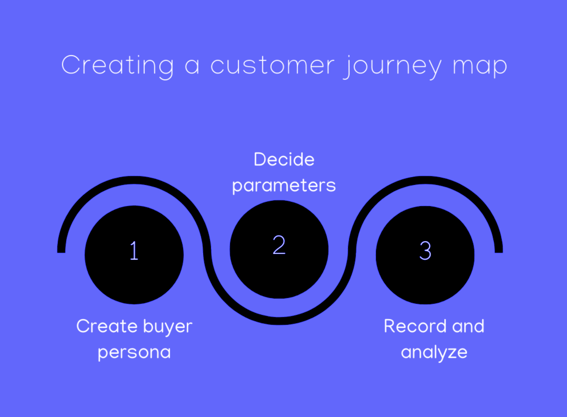Customer journey is a concept relevant to organizations globally, irrespective of their market size, niche, or target audience. According to a Salesforce survey, 66 percent of customers worldwide expect companies to understand their needs better.
While it is challenging to quantify customer satisfaction, it has been made easier with tactics such as developing customer journey maps and their analysis. This blog will discuss a customer journey map, how to map different customer journeys, the steps involved, and why it is essential to understand the customer journey. Lastly, we will cover the myths around customer journey mapping and how Auryc can help bust them. Let’s dive in.
What is a customer journey map?
A customer journey map provides a visual outline that explains the experiences, pain points, needs, and perceptions of your customer with your brand or business. In addition, it allows companies to analyze how customers interact with their website, social media posts, emails, or other communication channels. Finally, it helps to determine how customers will behave based on their needs and concerns. As a result, companies can boost their customer retention and conversion rates.
What is customer journey mapping?
Customer journey mapping is creating, collecting, and analyzing customer journey maps and extracting important related data patterns. It outlines the entire process of a customer’s experience with your business, starting from how they were made aware of your brand to what made them cancel their order at the last minute.

Customer journey mapping is an intensive process that maps a user's entire experience while navigating your business. Let’s discuss the various steps involved in the process and how they contribute to the end map.
What are the steps in a customer journey?
Using a customer journey map, we can understand how our target customers perceive our business. But, first, let’s learn the basic steps in creating this journey map.

Creating a buyer persona
A customer or buyer persona is a personalization of an average customer, their demographics, interests, location, and objectives for using your product. Understanding your buyer persona is vital in creating personalized experiences for them through your brand.
Deciding the parameters to analyze
You can identify touch points throughout the customer journey, whether you want to see how they interacted with your ads, when they decided to go ahead with a purchase, or how they reacted to the feedback form you sent them. Identifying these points and stages helps you visualize the journey map better.
Recording and analyzing the customer journey
The next step is, of course, systematically recording the customer journey. Using recording tools such as Auryc’s Session Replay, you can identify the rage clicks, the fluidity of the signup process, and the ease with which they get to the payment page. You can also gather actionable metrics data such as Page load Performance, Site Error Lost opportunity, Behavioral analysis, and Core Web Vitals that affect your business performance.
Once you gather the whole data, you can begin to understand the roadblocks or frustration points from your customer’s viewpoint. Then, with Smart Funnels, you can derive business actions that will help you tackle them. Smart Funnels tell you the “why” behind your customer actions and give actionable insights about their conversion or rejection rates.
Why are customer journey maps important?
While customer journey mapping is labor-intensive and time-consuming, its importance in modern-day business is well recognized. So why does your business need this data? First, let’s discuss some significant advantages of adopting this strategy.
Better customer onboarding
A perfect onboarding experience ensures a loyal customer. Customer journey maps ensure you take care of the initial pain points and give them a smoother onboarding experience. Therefore, establishing the credibility of your brand lays the foundation for a healthy buyer-seller relationship.
Comparing customer experience to their expectations
Customers perceive your brand from their first interaction, whether from your ads, your global image, or your website. Customer journey mapping helps marketing teams identify- met or exceeded expectations or any client dissatisfaction in the sales cycle. Feedback forms, website ratings, and session replays are a few data collection methods. Thus, you can make decisions that ensure customers get what they want.
Creating a logical order to your buyer journey
Every customer has a journey documented through a sales funnel. Whether they leave your website or app at the top of the funnel due to onboarding issues, at the middle of the funnel due to performance issues, or the end of the funnel due to payment gateway issues, everything is documented and analyzed in a customer journey map. In addition, a positive feedback form highlights what went well if the transaction or sale is successful. Hence, you can improve the overall customer experience with insights at every step of their buyer journey.
Five common myths of customer journey mapping
Customer journey mapping is an essential facet of modern-day business and has been accepted globally by various niche markets. However, the concept is still a work in progress and is often subject to one-off myths and misconceptions. Let’s dive deeper into the most common myths and pitfalls you might encounter while adopting this strategy.
One Size Fits All
Regarding customer behavior and satisfaction, there is no one size fits all feedback process. Your business's customer journeys must match multiple buyer personas and needs. Each of the buyer personas has different needs, expectations, and feedback for your product. Being customer-centric and trustworthy requires understanding each customer individually.
In the digital age, traditional marketing funnels do not work. That’s why most funnels cannot cope with the ever-changing needs of a digital customer, creating bland and ineffective journey maps. The need of the hour is something more innovative, to test various possibilities constantly to reach the optimal solution. This is where Auryc’s Smart Funnels come into play. With Auryc’s Smart Funnels, you can continuously change and optimize your customer journey maps to improve your ROI and customer experience.
Website behavior analysis is enough
While collecting and understanding website behavior is an essential step in the customer journey mapping process, it certainly isn't the end of the road.
Customers are real people, not robots analyzed based on their one-off interactions with your product. The continuous process requires multiple feedback channels such as rating forms, what made them click on your advertisements, and what ultimately made them leave. Website behavior analysis is just following a trail of clues, but the process extends beyond that. With Auryc’s Voice of Customer, collecting customer feedback becomes better and much more streamlined. Rather than receiving reports, you can get first-hand information that encapsulates the emotional context of their concern.
The customer journey map is a static destination
A customer journey map is not a pretty graphic that can be created and then forgotten. Instead, it requires constant improvements, changes in the parameters, updating the buyer personas over time, and monitoring changes that come with implementing new business decisions.
Journey maps are neither static nor linear. It constantly changes, adapting to the customer behavior and suggesting changes to improve their experience. With readily available tools such as Auryc’s Screen Replays, you can fulfill the need to tackle the frustration signals and make technical and revenue-specific decisions based on what is clicking with your customers and what is not.



